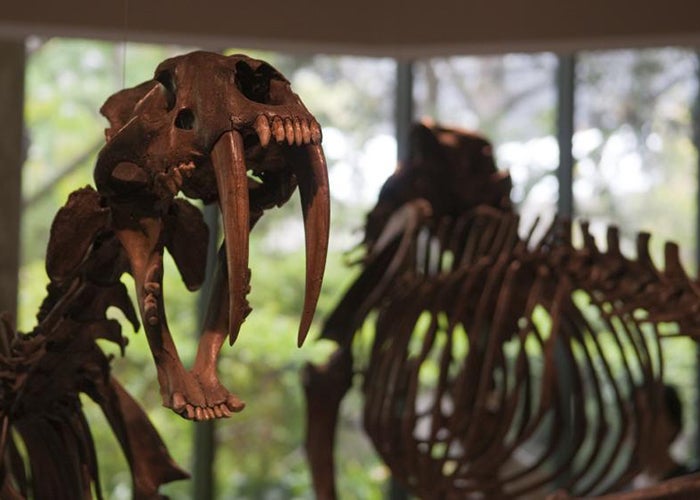
Dr. Robin O’Keefe to discuss his findings in free talk on Monday evening
Thursday, April 10, 2014
[social_share/]
HUNTINGTON, W.Va. – Concerns about climate change and its impact on the world around us are growing daily. New scientific studies by Marshall University paleontologist Dr. F. Robin O’Keefe and colleagues at the La Brea Tar Pits in Los Angeles are probing the link between climate warming and the evolution of Ice Age predators, attempting to predict how animals will respond to climate change today.
The La Brea Tar Pits are famous for the amazing array of Ice Age fossils found there, such as ground sloths, mammoths, and predators like saber-toothed cats and powerful dire wolves. But the climate during the end of the Ice Age (50,000-11,000 years ago) was unstable, with rapid warming and cooling. The new research has documented the impact of this climate change on La Brea predators for the first time.
Two new studies published by O’Keefe and Dr. Julie Meachen of Des Moines University, both of whom are research associates at the Page Museum at the La Brea Tar Pits, demonstrate significant change over time in the skulls of both dire wolves and saber-toothed cats.

“Different tar pits at La Brea accumulated at different times,” said O’Keefe, lead author on the dire wolf study (Palaeontologia Electronica, April 14, 2014). “When we compare fossils deposited at different times, we see big changes. We can actually watch evolution happening.”
After the end of the last Ice Age, La Brea dire wolves became smaller and more graceful, adapting to take smaller prey as glaciers receded and climate warmed. This rapidly changing climate drove change in saber-toothed cats as well.
“Saber-toothed cats show a clear correlation between climate and shape. Cats living after the end of the Ice Age are larger, and adapted to taking larger prey,” said Meachen, lead author on the sabertooth study (Journal of Evolutionary Biology, 2014) and a former instructor at Marshall.
“We can see animals adapting to a warming climate at La Brea,” said O’Keefe. “Then humans show up and all the big ones disappear. We haven’t been able to establish causality there yet. But we are working on it.”
He says the emerging links between climate change and evolution needs further study. There are many unanswered questions; such as why predators change in the ways that they do, the importance of factors other than climate and whether the arrival of humans played a role in the mass extinction at the end of the Ice Age.
John Harris, chief curator at the Page Museum, said, “There is much work to be done on the specimens from the tar pits. We are working actively to bring together the researchers and resources needed to expand on these discoveries. Climate change is a pressing issue for all of us, and we must take advantage of what Rancho La Brea can teach us about how ecosystems react to it.”
O’Keefe and Meachen talk about their work in a video here: http://youtu.be/jK_DKSNbgR4.
O’Keefe will discuss his findings in a free talk on the Huntington campus on Monday, April 14. The program will begin at 7 p.m. in Shawkey Dining Room of the Memorial Student Center. The program is free and open to the public.
O’Keefe’s research has taken him around the globe in search of prehistoric creatures. He is credited with the discovery of a new plesiosaur, Tatenectes laramiensis, a type of marine animal that lived during the late Jurassic age when large dinosaurs, including apatosaurus, stegosaurus and allosaurus, roamed the Earth. O’Keefe made the discovery in what is now the Devils Tower National Monument in Wyoming. In addition, his research produced the first evidence to establish that plesiosaurs gave birth to live young, rather than hatching their offspring from eggs on land. That study was published in the journal Science in 2011.
An associate professor of biology, O’Keefe has been on the Marshall faculty since 2006. He teaches human anatomy, introductory biology, comparative vertebrate anatomy and various graduate seminars, and serves as a graduate adviser. He received his bachelor’s degree in biology from Stanford University and his doctorate in evolutionary biology from the University of Chicago. He has published numerous scientific publications, and has served as a scientific adviser for National Geographic, IMAX and the Discovery Channel. He was named the university’s 2012-13 Distinguished John Deaver Drinko Academy Fellow.
His research is funded through grants from the National Science Foundation/West Virginia Experimental Program to Stimulate Competitive Research and NASA.
The dire wolf study will be available online beginning April 14 at palaeo-electronica.org/content/2014/723-canis-dirus-craniometrics. The sabertooth study is available at http://onlinelibrary.wiley.com/doi/10.1111/jeb.12340/abstract.
For more information, contact O’Keefe at 304-696-2427 or okeefef@marshall.edu.
Caption: O’Keefe and Meachen used more than 200 La Brea fossils in their research. Credit: Page Museum at the La Brea Tar Pits
Contact: Ginny Painter, Communications Director, Marshall University Research Corporation, 304.746.1964
